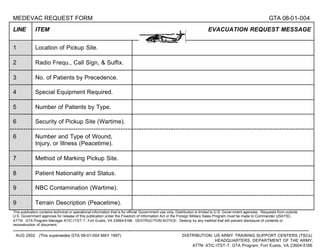
Medevac
- 1. MEDEVAC REQUEST FORM GTA 08-01-004 LINE ITEM EVACUATION REQUEST MESSAGE 1 Location of Pickup Site. 2 Radio Frequ., Call Sign, & Suffix. 3 No. of Patients by Precedence. 4 Special Equipment Required. 5 Number of Patients by Type. 6 Security of Pickup Site (Wartime). 6 Number and Type of Wound, Injury, or Illness (Peacetime). 7 Method of Marking Pickup Site. 8 Patient Nationality and Status. 9 NBC Contamination (Wartime). 9 Terrain Description (Peacetime). This publication contains technical or operational information that is for official Government use only. Distribution is limited to U.S. Government agencies. Requests from outside U.S. Government agencies for release of this publication under the Freedom of Information Act or the Foreign Military Sales Program must be made to Commander USATSC, ATTN: GTA Program Manager ATIC-ITST-T, Fort Eustis, VA 23064-5166. DESTRUCTION NOTICE: Destroy by any method that will prevent disclosure of contents or reconstruction of document. --------------------------------------------------------------------------------------------------------------------------------------------------- AUG 2002 (This supersedes GTA 08-01-004 MAY 1997) DISTRIBUTION: US ARMY TRAINING SUPPORT CENTERS (TSCs) HEADQUARTERS, DEPARTMENT OF THE ARMY, ATTN: ATIC-ITST-T, GTA Program, Fort Eustis, VA 23604-5166
- 2. LINE ITEM EXPLANATION 1. Location of Pickup Site. Encrypt grid coordinates. When using DRYAD Numeral Cipher, the same SET line will be used to encrypt grid zone letters and coordinates. To preclude misunderstanding, a statement is made that grid zone letters are in- cluded in the message (unless unit SOP specifies its use at all times). 2. Radio Frequency, Call Sign, Suffix. Encrypt the frequency of the radio at the pickup site, not a relay frequency. The call sign (and suffix if used) of person to be contacted at the pickup site may be transmitted in the clear. 3. No. of Patients by Precedence. Report only applicable info & encrypt brevity codes. A = Urgent, B = Urgent-Surg, C = Priority, D = Routine, E = Convenience. (If 2 or more categories reported in same request, insert the word “break” btwn. each category.) 4. Spec Equipment. Encrypt applicable brevity codes. A = None, B = Hoist, C = Extraction equipment, D = Ventilator. 5. No. of Patients by Type. Report only applicable information and encrypt brevity code. If requesting MEDEVACfor both types, insert the word “break” between the litter entry and ambulatory entry: L + # of Pnt -Litter; A + # of Pnt - Ambul (sitting). 6. Security Pickup Site (Wartime). N = No enemy troops in area, P = Possibly enemy troops in area (approach with caution), E = Enemy troops in area (approach with caution), X = Enemy troops in area (armed escort required). 6. Number and type of Wound, Injury, Illness (Peacetime). Specific information regarding patient wounds by type (gunshot or shrapnel). Report serious bleeding, along with patient blood type, if known. 7. Method of Marking Pickup Site. Encrypt the brevity codes. A = Panels, B = Pyrotechnic signal, C = Smoke Signal, D = None, E = Other. 8. Patient Nation- ality and Status. Number of patients in each category need not be transmitted. Encrypt only applicable brevity codes. A = US military, B = US civilian, C = Non-US mil, D = Non-US civilian, E = EPW. 9. NBC Contami- nation, (Wartime). Include this line only when applicable. Encrypt the applicable brevity codes. N = nuclear, B = biological, C = chemical. 9. Terrain Descrip- tion (Peacetime). Include details of terrain features in and around proposed landing site. If possible, describe the relationship of site to a prominent terrain feature ( lake, mountain, tower). Reference: FM 8-10-6, Medical Evacuation in a Theater of Operations, pages 7-7 through 7-9.